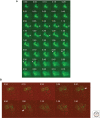Chemical gradients and chemotropism in yeast
- PMID: 20066086
- PMCID: PMC2742094
- DOI: 10.1101/cshperspect.a001958
Chemical gradients and chemotropism in yeast
Abstract
Chemical gradients of peptide mating pheromones are necessary for directional growth, which is critical for yeast mating. These gradients are generated by cell-type specific secretion or export and specific degradation in receiving cells. Spatial information is sensed by dedicated seven-transmembrane G-protein coupled receptors and yeast cells are able to detect extremely small differences in ligand concentration across their approximately 5-microm cell surface. Here, I will discuss our current knowledge of how cells detect and respond to such shallow chemical gradients and in particular what is known about the proteins that are involved in directional growth and the establishment of the polarity axis during yeast mating.
Figures




References
-
- Apanovitch DM, Slep KCKC, Sigler PB, Dohlman HG 1998. Sst2 is a GTPase-activating protein for Gpa1: Purification and characterization of a cognate RGS-Galpha protein pair in yeast. Biochemistry 37:4815–4822 - PubMed
-
- Arkowitz RA 1999. Responding to attraction: Chemotaxis and chemotropism in Dictyostelium and yeast. Trends Cell Biol 9:20–27 - PubMed
-
- Ayscough KR, Drubin DG 1998. A role for the yeast actin cytoskeleton in pheromone receptor clustering and signalling. Curr Biol 8:927–930 - PubMed
Publication types
MeSH terms
Substances
LinkOut - more resources
Full Text Sources
Molecular Biology Databases
